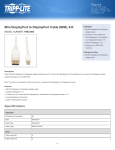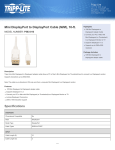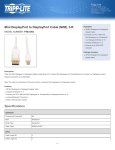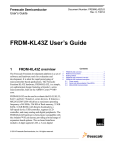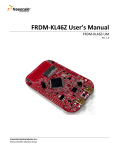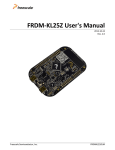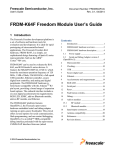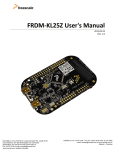Download FRDM-KL26Z User's Guide
Transcript
Freescale Semiconductor User’s Guide Doc Number: FRDMKL26ZUG Rev. 0, 10/2013 FRDM-KL26Z User’s Guide by 1 Freescale Semiconductor, Inc. Overview The Freescale Freedom development platform is a set of software and hardware tools for evaluation and development. It’s ideal for the rapid prototyping of microcontroller-based applications. The Freescale Freedom KL26Z hardware (FRDM-KL26Z) is a capable and cost-effective design featuring a Kinetis L series microcontroller, the industry’s first microcontroller built on the ARM® Cortex™-M0+ core. FRDM-KL26Z can be used to evaluate the KL16 and KL26 Kinetis L series devices. It features a KL26Z128VLH4, a device boasting a maximum operating frequency of 48MHz, 128KB of flash, a full-speed USB controller, and numerous analog and digital peripherals. The FRDM-KL26Z hardware is form-factor compatible with the Arduino™ R3 pin layout, providing a broad range of expansion board options. The on-board interfaces include an RGB LED, a 6-axis digital sensor (combining a 3D accelerometer and 3D magnetometer), ambient light sensor, and a capacitive touch slider. The FRDM-KL26Z features the Freescale open standard embedded serial and debug adapter known as OpenSDA. © 2013 Freescale Semiconductor, Inc. All rights reserved. 1. 2. 3. 4. 5. Contents Overview . . . . . . . . . . . . . . . . . . . . . . . . . . . . . . . . . . . Reference documents . . . . . . . . . . . . . . . . . . . . . . . . . Getting started . . . . . . . . . . . . . . . . . . . . . . . . . . . . . . . FRDM-KL26Z hardware overview . . . . . . . . . . . . . . FRDM-KL26Z hardware description . . . . . . . . . . . . . 1 2 2 2 5 Reference documents This circuit offers several options for serial communications, flash programming and run-control debugging. 2 Reference documents The table below provides a list of reference documents for the FRDM-KL26Z hardware. All of these documents are available online at www.freescale.com/FRDM-KL26Z. Table 1. FRDM-KL26Z reference documents Filename Description FRDM-KL26Z Quick Start Package Quick Start Guide and supporting files for getting started with the FRDM-KL26Z FRDM-KL26Z User’s Guide This document—overview and detailed information for the FRDM-KL26Z hardware FRDM-KL26Z Pinouts Spreadsheet of pin connections for all MCU pins. Includes pinout for the I/O headers, Arduino R3 compatibility chart, and OpenSDA MCU pinout. FRDM-KL26Z Schematics PDF schematics for the FRDM-KL26Z hardware FRDM-KL26Z Design Package Zip file containing all design source files for the FRDM-KL26Z hardware OpenSDA User’s Guide Overview and instructions for use of the OpenSDA embedded debug circuit 3 Getting started See the FRDM-KL26Z Quick Start Package for step-by-step instructions to get started with the FRDM-KL26Z. See the Jump Start Your Design section on www.freescale.com/FRDM-KL26Z for the Quick Start Package and software lab guides. 4 FRDM-KL26Z hardware overview The features of the FRDM-KL26Z include: • MKL26Z128VLH4 in a 64 LQFP package • Capacitive touch slider • FXOS8700CQ accelerometer and magnetometer • Tri-color (RGB) LED • Ambient light sensor • User push button • Flexible power supply options – USB, coin cell battery, external source • Battery-ready, power-measurement access points • Easy access to MCU I/O via Arduino™ R3 compatible I/O connectors • Programmable OpenSDA debug interface with multiple applications available including: — Mass storage device flash programming interface — P&E Debug interface provides run-control debugging and compatibility with IDE tools FRDM-KL26Z User’s Guide, Rev. 0 2 Freescale Semiconductor FRDM-KL26Z hardware overview — CMSIS-DAP interface: new ARM standard for embedded debug interface — Data logging application Figure 1 shows a block diagram of the FRDM-KL26Z design. The primary components and their placement on the hardware assembly are pointed out in Figure 2. Figure 1. FRDM-KL26Z block diagram FRDM-KL26Z User’s Guide, Rev. 0 Freescale Semiconductor 3 FRDM-KL26Z hardware overview $'(( )((* +$,-.-&$/ & !"#$% 0 , +$,-.)# !( Figure 2. FRDM-KL26Z feature call-outs FRDM-KL26Z User’s Guide, Rev. 0 4 Freescale Semiconductor FRDM-KL26Z hardware description 5 5.1 FRDM‐KL26Zhardwaredescription Power supply There are multiple power supply options on the FRDM-KL26Z. It can be powered from either of the USB connectors, the VIN pin on the I/O header, an on-board coin cell battery, or an off-board 1.71-3.6V supply from the 3.3V pin on the I/O header. The USB and VIN supplies are regulated on-board using a 3.3V linear regulator to produce the main power supply. The other two sources are not regulated on-board. Table 2 provides the operational details and requirements for the power supplies. Table 2. Power supply requirements Supply Source Valid Range OpenSDA Operational? Regulated on-board? OpenSDA USB (J7) 5V Yes Yes KL26Z USB (J5) 5V No Yes Vin 4.3-9V No Yes 3.3V pin 1.71-3.6V No No Coin cell battery 1.71-3.6V No No Note that the OpenSDA circuit is only operational when a USB cable is connected and supplying power to J10. However, protection circuitry is in place to allow multiple sources to be powered at once. Figure 3 shows the schematic drawing for the power supply inputs and the on-board voltage regulator. Figure 3. Power supply schematic In addition, regulated power can be supplied to J3 pin 10 from an external source through P5-9V_VIN by populating the board with an optional voltage regulator, e.g. a 7805 style regulator in a TO-220 package, thus providing a high current supply to external devices. To prevent voltage sag under a high load, C23, FRDM-KL26Z User’s Guide, Rev. 0 Freescale Semiconductor 5 FRDM-KL26Z hardware description C24, C25 & C28 should be populated with appropriately sized capacitors to match the regulator chosen. See Figure 4. Figure 4. Optional voltage regulator schematic Table 3. FRDM-KL26Z power supplies Power Supply Name Description P5-9V_VIN Power supplied from the Vin pin of the I/O headers (J3 pin 16) P5V_SDA Power supplied from the OpenSDA USB connector (J10). A Schottky diode provides back drive protection. P5V_KL26Z Power supplied from the KL26Z USB connector (J6). A Schottky diode provides back drive protection P3V3_VREG Regulated 3.3V supply. Sources power to the P3V3 supply rail with an optional back drive protection Schottky diode.1 2 P3V3_BATT P3V3 Coin cell battery supply voltage. Sources power to the P3V3 supply rail with the option of adding a back drive protection Schottky diode.3 Main supply rail for the FRDM-KL26Z assembly. May be sourced from P3V3_VREG, P3V3_BATT, or directly from the I/O headers (J3 pin 8). P3V3_KL26Z KL26Z MCU supply. Header J5 provides a convenient means for energy consumption measurements.4 P3V3_SDA OpenSDA circuit supply. Header J15 provides a convenient means for energy consumption measurements.4 P5V_USB Nominal 5V supplied to the I/O headers (J3 pin 10). Sourced from either the P5V_KL26Z or P5V_SDA supply through a back drive protection Schottky diode. FRDM-KL26Z User’s Guide, Rev. 0 6 Freescale Semiconductor FRDM-KL26Z hardware description 1 By default the linear regulator, U1, is a 3.3V output regulator. However, this is a common footprint that would allow the user to modify the assembly to utilize an alternative device such as a 1.8V or 2.5V regulator. The KL26Z microcontroller has an operating range of 1.71V to 3.6V. 2 D2 is bypassed by J14. By default, the pins of J14 are shorted together, to reduce the voltage drop across D2. To use D2, cut the trace between the pins of J14. 3 If a coin cell battery is to be used, add a small amount of solder to the coin cell ground pad before adding the battery holder. Also, it is recommended to populate D1 as a protection diode when using a coin cell battery. 4 J5 and J15 are not populated by default. The two pins of these headers are in parallel with 0 Ω resistors. In addition, J5 is also in parallel with a 10 Ω resistor. To measure the energy consumption of the KL26Z, either a voltmeter or an ammeter may be used. To use a voltmeter, R3 (0 Ω) must be removed before connecting the voltmeter probes to the pins of J5. Both R3 and R2 (10 Ω) must be removed to measure current with an ammeter. For the OpenSDA MCU, energy consumption can be measured by removing R4 (0 Ω) and connecting ammeter probes to the pins of J15. 5.2 Serial and debug adapter (OpenSDA) OpenSDA is an open standard serial and debug adapter. It bridges serial and debug communications between a USB host and an embedded target processor as shown in Figure 5. The hardware circuit is based on a Freescale Kinetis K20 family microcontroller (MCU) with 128 KB of embedded flash and an integrated USB controller. OpenSDA features a mass storage device (MSD) bootloader, which provides a quick and easy mechanism for loading different OpenSDA applications such as flash programmers, run-control debug interfaces, serial-to-USB converters, and more. See the OpenSDA User’s Guide for more details. Figure 5. OpenSDA high-level block diagram OpenSDA is managed by a Kinetis K20 MCU built on the ARM® Cortex™-M4 core. The OpenSDA circuit includes a status LED (D8) and a pushbutton (SW2). The pushbutton asserts a reset signal to the KL26Z target MCU. It can also be used to place the OpenSDA circuit into Bootloader mode. OpenSDA MCU RESET can be isolated from SW2 by cutting the trace between pins on J13. SPI and GPIO signals FRDM-KL26Z User’s Guide, Rev. 0 Freescale Semiconductor 7 FRDM-KL26Z hardware description provide an interface to the SWD debug port of the KL26Z. Additionally, signal connections are available to implement a UART serial channel. The OpenSDA circuit receives power when the USB connector J10 is plugged into a USB host. 5.2.1 Debug interface Signals with SPI and GPIO capability are used to connect directly to the SWD of the KL26Z. These signals are also brought out to a standard 10-pin (0.05”) Cortex Debug connector (J7). It is possible to isolate the KL26Z MCU from the OpenSDA circuit and use J7 to connect to an off-board MCU. To accomplish this, cut the trace on the bottom side of the PCB that connects J8 pin 1 to J8 pin 2. This will disconnect the SWD_CLK pin to the KL26Z so that it will not interfere with the communications to an off-board MCU connected to J7. Figure 6. SWD debug connector Note that J7 is not populated by default. A Samtec FTSH-105-02-F-D or compatible connector can be added to the J7 through-hole connector. A mating cable, such as a Samtec FFSD IDC cable, can then be used to connect from the OpenSDA of the FRDM-KL26Z to an off-board SWD connector. 5.2.2 Virtual serial port A serial port connection is available between the OpenSDA MCU and pins PTA1 and PTA2 of the KL26Z. Several of the default OpenSDA Applications provided by Freescale, including the MSD Flash Programmer and the P&E Debug Application, provide a USB communications device class (CDC) interface that bridges serial communications between the USB host and this serial interface on the KL26Z. 5.3 KL26Z microcontroller The target microcontroller of the FRDM-KL26Z is the KL26Z128VLH4, a Kinetis L series device in a 64 LQFP package. The KL26Z MCU features include: FRDM-KL26Z User’s Guide, Rev. 0 8 Freescale Semiconductor FRDM-KL26Z hardware description • • • • • • • • 32-bit ARM Cortex-M0+ core — Up to 48 MHz operation — Single-cycle fast I/O access port Memories — 128 KB flash — 16 KB SRAM System integration — Power management and mode controllers — Low-leakage wakeup unit — Bit manipulation engine for read-modify-write peripheral operations — Direct memory access (DMA) controller — Computer operating properly (COP) Watchdog timer Clocks — Clock generation module with FLL and PLL for system and CPU clock generation — 4 MHz and 32 kHz internal reference clock — System oscillator supporting external crystal or resonator — Low-power 1kHz RC oscillator for RTC and COP watchdog Analog peripherals — 16-bit SAR ADC w/ DMA support — 12-bit DAC w/ DMA support — High speed comparator Communication peripherals — Two 16-bit Serial Peripheral Interfaces (SPI) — USB dual-role controller with built-in FS/LS transceiver — USB voltage regulator — Two I2C modules — One low-power UART and two standard UART modules — One I2S module Timers — One 6-channel Timer/PWM module — Two 2-channel Timer/PWM modules — 2-channel Periodic Interrupt Timer (PIT) — Real time clock (RTC) — Low-power Timer (LPTMR) — System tick timer Human-Machine Interfaces (HMI) — General purpose input/output controller FRDM-KL26Z User’s Guide, Rev. 0 Freescale Semiconductor 9 FRDM-KL26Z hardware description — Capacitive touch sense input interface hardware module 5.3.1 Clock source The Kinetis KL26 microcontrollers feature an on-chip oscillator compatible with three ranges of input crystal or resonator frequencies: 32-40 kHz (low freq. mode), 3-8 MHz (high frequency mode, low range) and 8-32 MHz (high frequency mode, high range). The KL26Z128 on the FRDM-KL26Z is clocked from an 8 MHz crystal. 5.3.2 USB interface The Kinetis KL26 microcontrollers feature a dual-role USB controller with on-chip full-speed and low-speed transceivers. The USB interface on the FRDM-KL26Z is configured as a full-speed USB device. J6 is the USB connector for this interface. Figure 7. USB connector schematic In order to enable USB host functionality on the FRDM-KL26Z, it is necessary to populate J9 and R8 as shown in Figure 7. However, there is no electrical protection provided. Use the USB host functionality at your own risk. FRDM-KL26Z User’s Guide, Rev. 0 10 Freescale Semiconductor FRDM-KL26Z hardware description 5.3.3 Serial port The primary serial port interface signals are PTA1 and PTA2. These signals are connected to both the OpenSDA and to the J1 I/O connector. Note that the OpenSDA connection can be isolated from J1 by removing R13 & R14, if required. 5.3.4 Reset The PTA20/RESET signal on the KL26Z128 is connected externally to a pushbutton, SW2, and also to the OpenSDA circuit. However, J13 has been provided to isolate the OpenSDA MCU from SW2. Isolating the RESET line allows a more accurate measurement of the target device’s power consumption in low-power modes. The reset button can be used to force an external reset event in the target MCU. The reset button can also be used to force the OpenSDA circuit into bootloader mode. See Section 5.2, “Serial and debug adapter (OpenSDA), for more details. 5.3.5 Debug The sole debug interface on all Kinetis L Series devices is a serial wire debug (SWD) port. The primary controller of this interface on the FRDM-KL26Z is the onboard OpenSDA circuit (see Section 5.2, “Serial and debug adapter (OpenSDA)). However, an unpopulated 10-pin (0.05”) Cortex Debug connector, J7, provides access to the SWD signals. The Samtec FTSH-105-02-F-D or compatible connector can be added to the J7 through-hole debug connector to allow for an external debug cable to be connected. 5.4 Capacitive touch slider Two Touch Sense Input (TSI) signals, TSI0_CH9 and TSI0_CH10, are connected to capacitive electrodes configured as a touch slider. Freescale’s Touch Sense Software (TSS) provides a software library for implementing the capacitive touch slider. 5.5 6-axis accelerometer and magnetometer A Freescale FXOS8700CQ low-power, six-axis accelerometer and magnetometer is interfaced through an I2C bus and two GPIO signals as shown in Table 4. By default, the I2C address is 0x1D (SA0 pulled high). Table 4. Accelerometer signal connections FX0S8700CQ KL26Z128 SCL PTE24 SDA PTE25 INT1 PTD0 INT2 PTD1 FRDM-KL26Z User’s Guide, Rev. 0 Freescale Semiconductor 11 FRDM-KL26Z hardware description Figure 8. FXOS8700CQ schematic diagram 5.6 RGB LED Three PWM-capable signals are connected to a red, green, blue LED, D7. The signal connections are shown in Table 5. Table 5. RGB LED signal connections 1 RGB LED KL26Z128 Red cathode PTE29 Green cathode PTE31 Blue cathode PTD51 PTD5 is also connected to the I/O header on J2 pin 10 (also known as D13). Figure 9. RGB LED schematic diagram FRDM-KL26Z User’s Guide, Rev. 0 12 Freescale Semiconductor FRDM-KL26Z hardware description 5.7 Ambientlightsensor An ambient light sensor is connected to ADC0_SE3 (PTE22). This sensor may be isolated from PTE22 by removing R36. 5.8 Input/Output connectors The KL26Z128VLK4 microcontroller is packaged in a 64-pin LQFP. Some pins are utilized in on-board circuitry, but many are directly connected to one of four I/O headers. The pins on the KL26Z microcontroller are named for their general purpose input/output port pin function. For example, the 1st pin on Port A is referred to as PTA1. The I/O connector pin names are given the same name as the KL26Z pin connected to it, where applicable. FRDM-KL26Z User’s Guide, Rev. 0 Freescale Semiconductor 13 FRDM-KL26Z hardware description Note that all pinout data is available in spreadsheet format in FRDM-KL26Z Pinouts. See Section 2, “Reference documents” for details. 5.9 Analog reference voltage The onboard ADC of the KL26Z128VLH4 MCU uses the Reference Voltage High (VREFH) and Reference Voltage Low (VREFL) pins to set high and low voltage references for the analog modules. On the FRDM-KL26Z, by default VREFH is attached to P3V3_KL26Z (3.3V Supply). VREFL is connected to GND. Figure 10 illustrates this circuitry. Figure 10. FRDM-KL26Z VREFH circuit schematic If desired, VREFH can use a VDDA independent reference by adding R11 and a Zener diode (D6). R10 (0 Ω resistor) must be removed when implementing this option. Alternatively, VREFH can be attached to an external source through AREF by removing R10 and populating R9 with a 0 Ω resistor. 5.10 Arduino compatibility The I/O headers on the FRDM-KL26Z are arranged to allow compatibility with peripheral boards (known as shields) that connect to Arduino™ and Arduino-compatible microcontroller boards. The outer rows of pins (the even numbered pins) on the headers share the same mechanical spacing and placement as the I/O headers on the Arduino Revision 3 (R3) standard. FRDM-KL26Z User’s Guide, Rev. 0 14 Freescale Semiconductor FRDM-KL26Z hardware description Refer to the FRDM-KL26Z Pinouts spreadsheet for a compatibility chart showing how all the functions of the KL26Z signals on the I/O connectors map to the pin functions available on the Arduino Uno R3. FRDM-KL26Z User’s Guide, Rev. 0 Freescale Semiconductor 15 How to Reach Us: Information in this document is provided solely to enable system and software Home Page: freescale.com implementers to use Freescale products. There are no express or implied copyright Web Support: freescale.com/support information in this document. licenses granted hereunder to design or fabricate any integrated circuits based on the Freescale reserves the right to make changes without further notice to any products herein. Freescale makes no warranty, representation, or guarantee regarding the suitability of its products for any particular purpose, nor does Freescale assume any liability arising out of the application or use of any product or circuit, and specifically disclaims any and all liability, including without limitation consequential or incidental damages. “Typical” parameters that may be provided in Freescale data sheets and/or specifications can and do vary in different applications, and actual performance may vary over time. All operating parameters, including “typicals,” must be validated for each customer application by customer’s technical experts. Freescale does not convey any license under its patent rights nor the rights of others. Freescale sells products pursuant to standard terms and conditions of sale, which can be found at the following address: freescale.com/SalesTermsandConditions. Freescale, the Freescale logo, and Kinetis are trademarks of Freescale Semiconductor, Inc., Reg. U.S. Pat. & Tm. Off. ARM is the registered trademark of ARM Limited. ARM Cortex-M0+ is the trademark of ARM Limited. All other product or service names are the property of their respective owners. © 2013 Freescale Semiconductor, Inc. Document Number: FRDMKL26ZUG Rev. 0 10/2013
















